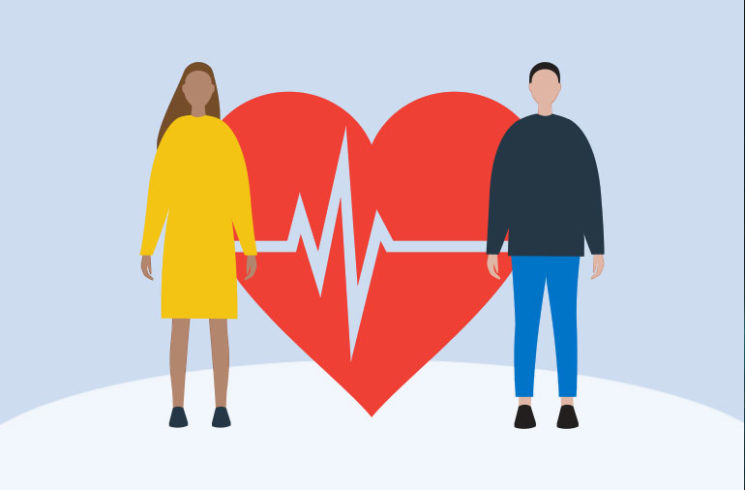Don’t go breakin’ your own heart
Texas A&M AgriLife supports mindful efforts to reduce risk of heart disease during American Heart Month
It’s only fitting that the month featuring Valentine’s Day would also be designated American Heart Month. Texas A&M AgriLife experts have advice and programs to help people maintain and improve their heart health.
“February was designated American Heart Month to bring attention and awareness to the prevalence and severity of heart disease in the U.S.,” said Rebecca Seguin-Fowler, Ph.D., professor in the Department of Nutrition at the Texas A&M College of Agriculture and Life Sciences and associate director for Texas A&M AgriLife Research, Bryan-College Station.
Heart disease is the leading cause of death in the U.S., accounting for about one-fourth of all deaths annually. In the U.S., it is the No. 1 cause of death among women as well as men.
“While such statistics are alarming, heart disease is often preventable and there are many things people can do to reduce their risk,” Seguin-Fowler said. “These include knowing your risk, eating wisely, getting regular physical activity, making sure you get at least eight hours of sleep, having regular medical checkups and managing existing conditions that can lead to heart disease.”
Coronary heart disease risk
“There are many risk factors for coronary heart disease, and the risk increases with the number of factors and how serious they are,” said Amy Valdez, Texas A&M AgriLife Extension Service program specialist for the Healthy South Texas initiative, Weslaco.
Some risk factors and lifestyle behaviors, which can put individuals at a higher risk of heart disease, include high blood pressure, high cholesterol, unhealthy eating, sedentary lifestyle or inactivity, overweight and obesity, or excessive alcohol or tobacco use, Valdez said.
“While factors like age, family history and genetics can’t be changed, certain risk factors like high blood pressure and high blood cholesterol can be addressed through medication and by adopting a more heart-healthy lifestyle,” she said.
Develop a baseline and track progress
Self-monitoring is important to knowing risk and keeping on track with heart health goals, Seguin-Fowler said.

“Know where you are on the risk scale for heart disease, and get a health professional’s input on the nutritional and behavioral steps you can take to reduce that risk,” she said.
The My Life Check online interactive tool of the American Heart Association can help people assess and track their heart health information to better understand their risk of heart disease and stroke.
Some other information that will help determine risk includes:
— Body mass index, which is an estimate of body fat. Being overweight puts you at higher risk for heart disease and stroke, high cholesterol, high blood pressure and diabetes.
— Blood pressure. Ask your doctor what the target numbers for your blood pressure should be and how often you should check it, keeping track of those numbers.
— Cholesterol levels. A blood test can show whether your low-density lipoprotein, LDL, and high-density lipoprotein, HDL, cholesterol levels are healthy. Talk with your doctor about having your cholesterol tested, how often to have it tested and what the appropriate HDL and LDL levels should be.
“Talk to your primary care physician about your heart health risk and, if needed, develop a treatment plan to help stabilize blood pressure, blood sugar and blood cholesterol levels,” Seguin-Fowler said. “Many people still need medication for high blood pressure or cholesterol even after they make more positive heart-healthy lifestyle changes.”
She said keeping track of weight, blood pressure, cholesterol levels and other measures will show how well you are moving toward your heart-health goals.
“Some online tools, electronic devices and apps can help in collecting and tracking this information,” she said. “You can also keep and update a daily food and drink diary and/or maintain a physical activity log to track the amount and type of your daily exercise.”
Physical activity
Exercise can help you shed extra pounds that may cause additional strain on the heart, improve heart strength, lower bad cholesterol levels, increase good cholesterol levels and lower blood pressure.
“Regular physical activity is beneficial for a variety of reasons, including helping reduce the risk of heart disease by lowering blood pressure and certain blood lipids such as LDL cholesterol,” Seguin-Fowler said. “It also aids in weight loss and maintenance.”
To gain these health benefits, adults should participate in at least 150 minutes of moderate-intensity aerobic activity per week and include muscle-strengthening activities. This can be through brisk walking, recreational swimming, yoga or other moderate-intensity activities. Preferably, this activity should be spread out over the week.
“Almost any type of physical activity is better than being sedentary, and there are many ways to get 150 minutes of exercise per week inside and outside the home,” Seguin-Fowler said.
Michael Lopez, AgriLife Extension program specialist, Bryan-College Station, said getting involved in a team-based or community-wide fitness initiative such as the agency’s Walk Across Texas! challenge is a good way to develop a regular physical activity habit.
“Walk Across Texas! is an eight-week program in which teams work together to complete at least 832 miles of walking activity or the equivalent,” he said. “Those 832 miles or more are the goal since that represents the distance between the two farthest-apart points in the state.”
Healthy diet
Consuming high amounts of saturated fats or trans fats and refined carbohydrates can lead to overweight and obesity, high blood cholesterol and atherosclerosis.

“A healthy, well-balanced diet low in sodium and saturated fat is key to heart disease prevention,” Valdez said. “Some of the dietary items in a heart-healthy diet include lean meats, fish, vegetables, fruits, whole grains, beans, nuts, and fat-free or low-fat dairy products. Not only are these foods great for our heart health, but they provide vitamins, minerals and other nutrients our body needs to function properly on a daily basis.”
She suggested limiting foods high in saturated fat, sodium and added sugars.
“It is recommended to limit sodium intake to 2,300 milligrams per day, and limit intake of both saturated fat and added sugars so each is no more than 10% of your daily caloric needs,” she said.
Valdez also advised limiting alcohol intake to two drinks per day for men and one per day for women to help reduce the risk of heart disease.
Another area of nutrition for heart health is eating foods rich in heart-healthy omega-3 fatty acids, which are found in fish and seafood as well as many in plant-based sources, such as nuts, seeds and vegetable oils.
Reducing stress through mindfulness
Stress can trigger constriction of the arteries, which increases the risk of coronary heart disease, especially coronary microvascular disease. It may also indirectly raise the risk of coronary heart disease if it leads to poor stress-management behaviors such as smoking or overeating. Stress can also affect energy and hunger and, if chronic, can cause the body to store more fat.

“Find a way to cope with stress through exercise, meditation, painting, reading a book, taking a nature walk or whatever positive activity works for you,” said Miquela Smith, AgriLife Extension program specialist – health, Lubbock. “Identify and practice those coping strategies before you are stressed, overwhelmed or anxious. Under stress, it is easier for your brain to engage in the type of activities it is familiar with rather than those it is not.”
Smith said it is important to make a deliberate attempt to live “mindfully” in the present moment as much as possible to avoid getting caught in cycles of lamenting over the past or worrying about the future.
“Paying attention to the present, on purpose, and without judgment can help improve your overall emotional health,” she said. “It can also benefit your physical health.”
Smith noted that several studies have found that mindfulness can be used to manage chronic health conditions and modestly lower blood pressure—a key marker of heart health.
“One of the best things people can do to promote their overall health is to take up some kind of meditative practice and/or purposely incorporate activities that ground them and/or help them relax,” she said.
Kicking bad habits
Smoking not only causes damage to the lungs, but the chemicals in tobacco smoke can also harm the heart and blood vessels. There is also scientific evidence that the flavorings found in vaping products can damage the heart and lungs.
“There are a number of tools available to help people quit smoking,” Seguin-Fowler said. “But perhaps the most important aspect of smoking cessation is having a support system that can encourage and help you.”
She said people under the impression that taking up vaping instead of smoking is a reasonable tradeoff for heart health are sadly mistaken.
“If you don’t smoke or vape, the best thing you can do is not start. If you do, the best thing you can do is quit.”



